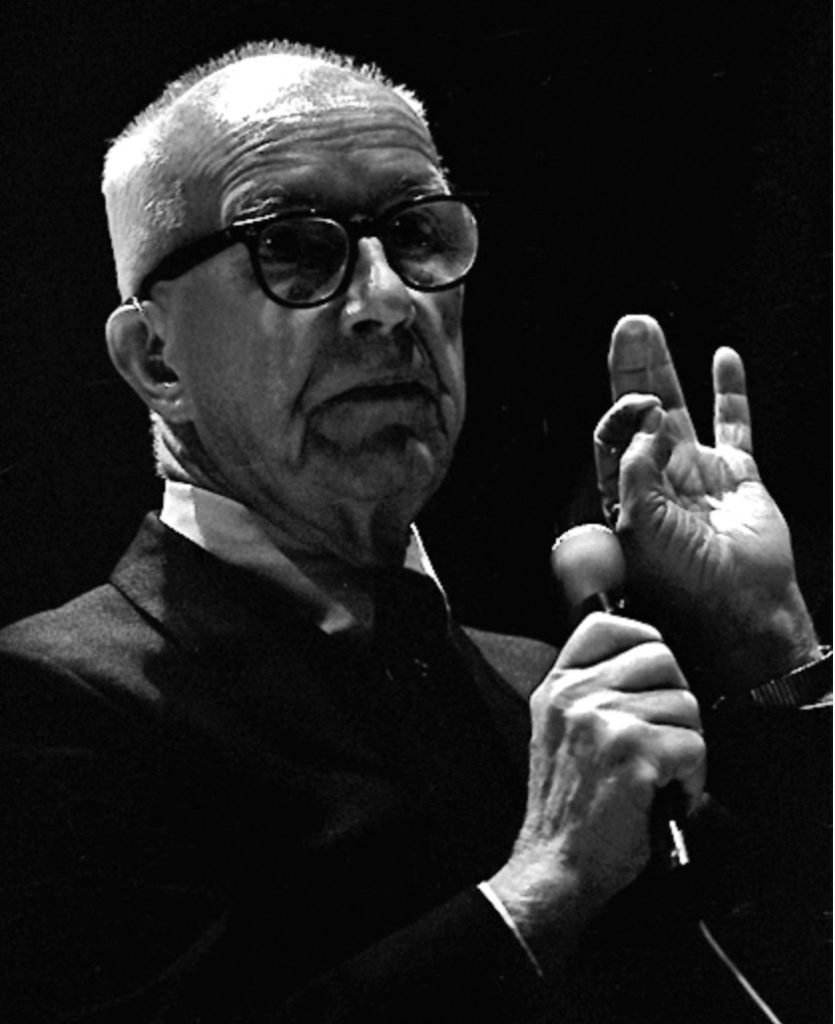
Buckminster Fuller 1895 – 1983
Buckminster Fuller was born on July 12, 1895 in Milton, Massachusetts, the second of four children. His father, a successful merchant, died prematurely of a stroke when Bucky was ten. Young Bucky showed signs of seriously impaired vision that was corrected with Coke-bottle glasses at age 4. After receiving the lenses, he began to excel. By age 6, he had already built his first tetrahedral octet truss out of toothpicks and dried peas. This kindergarten creation was a simplistic model for the geodesic dome that he would perfect forty years later. As a young lad, he was precocious but not well adjusted. Like many other visionaries he was bored with the needless routine and often didn’t bother to attend class. By age 12, Bucky was already driving a car and by age 21, he had flown an open-cockpit plane.
Fuller attended Milton Academy and Harvard, where his perceived “weirdness” made him feel like an outsider. In the words of his biographer Alden Hatch:
The plain truth is that Bucky was too individualistic, too much of an oddball in thought and appearance, to meet the conformist standards of those young, so-sure-of-themselves aristocrats. He was short, carelessly dressed, with a head much too large for his body. His teeth, which had not then been straightened, were oddly arranged and those enormous magnifying lenses made his eyes look like big pools of amber liquid.
Bucky’s desire for acceptance led him to display excessive “party animal” behavior. On one occasion, he withdrew his stipend that was to be used for tuition, books, etc. and traveled to New York City where he attended the Zigfeld Follies. He threw a lavish party to which he invited half the Zigfeld Follies chorus line. When it was discovered that he had squandered his entire stipend for living expenses and incurred further bills, Harvard expelled him for what they termed “irresponsible conduct.”
His mother used influence to get the wayward man-child a job in Canada until the next term, September 1914, when Harvard reinstated him. His performance, once again, regressed to what it had been before and Harvard expelled him for the second and last time for “lack of sustained interest in the processes within the university.”
When the U.S. entered World War I, Bucky enlisted in the Navy, where he educated himself in mathematics, hydraulics, and aeronautical engineering. However, after the war, Bucky embarked on a number of professions, but each led nowhere. By 1922, he was unemployed and deep in debt. To alleviate a growing feeling of foreboding, he attended a Harvard-Yale football game and spent the weekend rediscovering his party days. On his return home, his wife Anne, sobbing uncontrollably, informed him that their daughter Alexandra was seriously ill with polio. She died a few hours later in his arms–on her fourth birthday. Bucky blamed himself for not being around during her illness and went into a depression.
During the next five years, Buckminster plunged into several entrepreneurial ventures, but despite the creativity of his inventions, his lack of business experience resulted in the ultimate failure of his companies. On a cold windy winter night in 1927, Bucky walked to Lake Michigan intent on suicide. At the age of 32, he looked in the mirror and concluded,
I’ve done the best I know how and it hasn’t worked. I guess I’m just no good, even my mother said I was worthless. I guess she was right.
Bucky stood at the edge of the frigid water preparing to stop the hurt. He had reached what he later called a “critical detonation point.” Suddenly, he experienced an epiphany. It occurred to him that he was different but that the difference might be an asset rather than a liability. He walked home, told his wife of his decision, and set out on his journey to contact his inner self. He later wrote, “I decided to unlearn and drop out from conventional thinking. I am going to embark on a new life mission.”
In the years that followed, Buckminster Fuller became a celebrated inventor and visionary. His inventions included the Dymaxion House, the Dymaxion car, and most notably, the geodesic dome. His investigations of spheres and tetrahedra led him to develop a variety of different kinds of polyhedra. Among these was the so-called truncated spherical icosahedron which is a formal name for the shape that is modeled by a soccer ball. In 1985, two scientists, Harry Kroto and Richard Smalley, proved that a 60-atom carbon molecule (denoted C60) has the shape of truncated spherical icosahedron with one carbon atom located at each vertex. To honor Bucky Fuller who had died two years earlier, they named the molecule buckminsterfullerene –subsequently nicknamed buckyball. More information on Fuller is available at: https://www.intelligence-and-iq.com/entrepreneurial-genius/.
